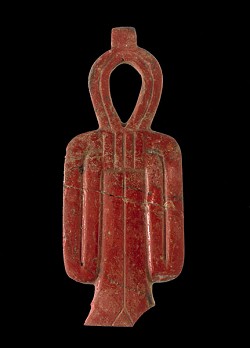
This sign, called tit by the Egyptians, was interpreted from the New Kingdom on as a symbol of Isis in particular, but also Nephthys. The Isis knot is similar in shape and use to the ankh sign, the symbol of life, and is also often found in association with the djed-pillar and the was-sceptre.
Its interpretation is uncertain; it has been linked to menstruation and seen as a depiction of the vagina and uterus. Its original purpose was perhaps as a means of protection, knotted by Re-Atum and placed in the pregnant Isis's womb to prevent Seth harming the unborn child or causing a miscarriage. Chapter 156 of the Book of the Dead confirms that the fertility of Isis, linked with blood, is intact. Thus the Isis knot is sometimes called Isis blood, and pregnant women used the magic spells linked with it to prevent undesired bleeding and miscarriages. During excavations, the Isis knot has been found tucked between the legs of pregnant women. According to Bonnet, it is by no means certain that there is any link between the blood of Isis and the tit-knot, which resembles the gordellus used to depict gods. He points out that the expectations linked to the tit as an amulet were very general, and that tit-amulets have also been found with shabti spells written on them. The red colour that the tit usually has, however, does suggest a connection with the blood of Isis. A different interpretation is proposed by Lurker, who suggests that the djed-pillar and Isis blood together indicate a unification of polarity and thus the victoriousness of the life force.